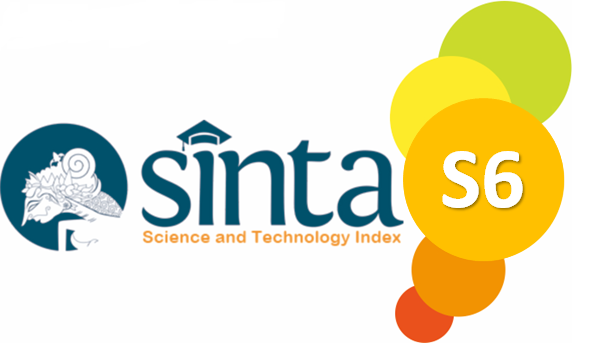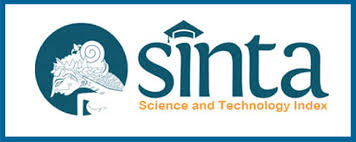Behavioring Digitally Healthy Increasing Knowledge On Myopia Prevention
Abstract
Cases of myopic visual impairment in school age children increased during the pandemic. The purpose of this study was to increase parents' knowledge of the protection of myopia health in children during a pandemic after being given an intervention. This study used a quasi experimental study approach and the design of The One Group Pretest Posttest. The population was parents with school age children between 6 until 10 years old at SD Al Huda. The sample in this study were 28 parents with school age children between 6 until 10 years old at SD Al Huda who were willing to be involved in this intervention. The method used is a lecture with a webinar using a zoom application about myopia visual impairment. The components of interventions are the definition, the classifications, the impact, the risk factors, and the protective factors of myopia. The research instrument is a questionnaire in a google form. It is given before and after the intervention. Data analysis used the Wilcoxon Rank Test. The results found an increase in the knowledge of parents on myopia health protection by 0.019
References
Arimbawa, P. E., Gede, I. P., Purwa, A., & Wardhana, Z. F. (2021). Health belief model and the understanding of rational use of medicines. International Journal of Public Health Science, 10(2), 411–417. https://doi.org/10.11591/ijphs.v10i2.20737
Camhi, S. S., Shah, K., & Cavuoto, K. M. (2020). Pediatric Eye Care: We Cannot Lose Sight of Its Importance despite the COVID-19 Pandemic. Journal of Binocular Vision and Ocular Motility, 70(4), 147–149. https://doi.org/10.1080/2576117X.2020.1830677
Cimberle, M. (2020). Increased digital screen time during COVID-19 may accelerate myopia epidemic. Healio. https://www.healio.com/news/ophthalmology/20201014/increased-digital-screen-time-during-covid19-may-accelerate-myopia-epidemic
Ebner, C., & Gegenfurtner, A. (2019). Learning and Satisfaction in Webinar, Online, and Face-to-Face Instruction: A Meta-Analysis. Frontiers in Education, 4. https://doi.org/10.3389/feduc.2019.00092
Hosoda, Y., Yoshikawa, M., Miyake, M., Tabara, Y., Shimada, N., Zhao, W., Oishi, A., Nakanishi, H., Hata, M., Akagi, T., Ooto, S., Nagaoka, N., Fang, Y., Kawaguchi, T., Setoh, K., Takahashi, Y., Kosugi, S., Nakayama, T., Ohno-Matsui, K., … Yamashiro, K. (2018). CCDC102B confers risk of low vision and blindness in high myopia. Nature Communications, 9(1), 1–7. https://doi.org/10.1038/s41467-018-03649-3
Mohalik, R., & Poddar, S. (2020). Effectiveness of Webinars and Online Workshops during the COVID-19 Pandemic. SSRN Electronic Journal, 13(34), 2–4. https://doi.org/10.2139/ssrn.3691590
Nisaussholihah, N., Faradis, H., Roesbiantoro, A., Muhammad, D., & Salim, H. (2020). Pengaruh Penggunaan Gadget Terhadap Kejadian Miopia Pada Anak Usia Sekolah (4-17 Tahun) Di Poli Mata Rumah Sakit Islam Jemursari Surabaya. Jurnal Kesehatan Islam?: Islamic Health Journal, 9(2), 55. https://doi.org/10.33474/jki.v9i2.8872
Ratulangi, S., & Lan, S. (2020). Analisis Efektivitas Penggunaan Media Webinar dalam Pengembangan Kualitas Guru Analysis of the Effectiveness of Using the Webinar Medium in Teacher Development. Prosiding Konferensi Nasional Ilmu Administrasi 4.0, 217–222.
Scott, L.D., Jacks, L. L. (2017). Promoting Healthy Lifestyles in Urban and Rural Elders. Online Journal of Rural Nursing and Health Care, 1(2).
Spillmann, L. (2020). Stopping the rise of myopia in Asia. Graefe’s Archive for Clinical and Experimental Ophthalmology, 258(5), 943–959. https://doi.org/10.1007/s00417-019-04555-0
Stefan, N., & O, von dem K. (2020). Effectiveness of Community-Based Health Promotion Interventions in Urban Areas: A Systematic Review. Journal of Community Health, 45(2), 419–434. https://doi.org/10.1007/s10900-019-00733-7.
Sumitro, S., J, H. K., & Istiono, W. (2019). The Effect of Lecture and Small Group Discussion Method in Health Education Towards Dengue Haemorrhagic Fever Vector Larva Free Proportion in Gunungkidul Regency. Review of Primary Care Practice and Education (Kajian Praktik Dan Pendidikan Layanan Primer), 2(1), 25. https://doi.org/10.22146/rpcpe.44471
Upadhyay, S. (2015). Myopia, Hyperopia and Astigmatism: A Complete Review with View of Differentiation. International Journal of Science and Research (IJSR) ISSN (Online Index Copernicus Value Impact Factor, 4(8), 2319–7064. http://www.ijsr.net/archive/v4i8/SUB157086.pdf
Vadhariya, A., & Sansgiry, S. S. (2015). Use of Health belief model to understand Knowledge, Attitudes And Behaviors of People Towards The Ebola outbreak. Value in Health, 18(3), A241. https://doi.org/10.1016/j.jval.2015.03.1405
Wang, J., Li, Y., Musch, D. C., Wei, N., Qi, X., Ding, G., Li, X., Li, J., Song, L., Zhang, Y., Ning, Y., Zeng, X., Hua, N., Li, S., & Qian, X. (2021). Progression of Myopia in School-Aged Children after COVID-19 Home Confinement. JAMA Ophthalmology, 139(3), 293–300. https://doi.org/10.1001/jamaophthalmol.2020.6239
Wardani, E. M., Bistara, D. N., & Septianingrum, Y. (2021). Promosi Kesehatan Pencegahan Penularan Infeksi Covid-19 Pada Masyarakat Melalui Webinar Series. Dedication?: Jurnal Pengabdian Masyarakat, 5(1), 71–76. https://doi.org/https://doi.org/10.31537/dedication.v5i1.441
World Health Organization. (2015). The Impact of Myopia and High Myopia. In World Health Organization–Brien Holden Vision Institute (Issue March). https://www.who.int/blindness/causes/MyopiaReportforWeb.pdf
Wu, P., Huang, H., & Yu, H. (2016). Epidemiology of Myopia. 5(6), 386–393. https://doi.org/10.1097/APO.0000000000000236
Zare, M., Ghodsbin, F., Jahanbin, I., Ariafar, A., Keshavarzi, S., & Izadi, T. (2016). The effect of health belief model-based education on knowledge and prostate cancer screening behaviors: A randomized controlled trial. International Journal of Community Based Nursing and Midwifery, 4(1), 57–68.












